 W
W400 Years of the Telescope: A Journey of Science, Technology and Thought is a 2009 American documentary film that was created to coincide with the International Year of Astronomy in 2009. Directed by Kris Koenig, it chronicles the history of the telescope from the time of Galileo and features interviews with leading astrophysicists and cosmologists from around the world, who explain concepts ranging from Galileo's first use of the telescope to view the moons of Jupiter, to the latest discoveries in space, including new ideas about life on other planets and dark energy, a mysterious vacuum energy that is accelerating the expansion of the universe.
 W
WAlien Planet is a 94-minute docufiction, originally airing on the Discovery Channel, about two internationally built robot probes searching for alien life on the fictional planet Darwin IV. It was based on the book Expedition, by sci-fi/fantasy artist and writer Wayne Douglas Barlowe, who was also executive producer on the special. It premiered on May 14, 2005.
 W
WA Beautiful Planet is a 2016 American documentary film that explores Earth by showing IMAX footage, recorded over the course of fifteen months by astronauts aboard the International Space Station. It is narrated by actress Jennifer Lawrence.
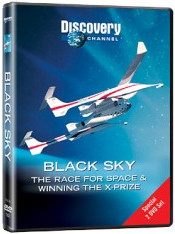 W
WBlack Sky: The Race For Space is a 2004 Discovery Channel documentary about Space Ship One, and how a small team backed by Paul Allen achieved human suborbital spaceflight and won the Ansari X Prize. It contains insights about how the rocketplane was built, the challenges they faced when they flew it, the vision of Burt Rutan about the future of this technology, and his thoughts about NASA and government. It won a Peabody Award in 2004.
 W
WCosmic Birth is a 2019 Icelandic documentary film about mankind's journey to the Moon and the experience of viewing the Earth from a quarter of a million miles away. The film also looks into the role that Iceland played in the training of the Apollo astronauts for the first manned missions to another world. Cosmic Birth is written and directed by Exploration Museum founder Örlygur Hnefill Örlygsson and filmmaker and musician Rafnar Orri Gunnarsson.
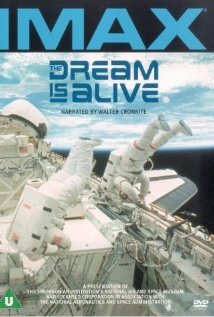 W
WThe Dream is Alive is an IMAX documentary film, released in June 1985, about NASA's Space Shuttle program. The film was narrated by Walter Cronkite, and directed by Graeme Ferguson.
 W
WFirst Orbit is a 2011 feature-length, experimental documentary film about Vostok 1, the first manned space flight around the Earth. By matching the orbit of the International Space Station to that of Vostok 1 as closely as possible, in terms of ground track and time of day, documentary filmmaker Christopher Riley and European Space Agency astronaut Paolo Nespoli were able to film the view that Yuri Gagarin saw on his pioneering orbital space flight. This new footage was cut together with the original Vostok 1 mission audio recordings sourced from the Russian State Archive of Scientific and Technical Documentation. The film features the music of composer Philip Sheppard.
 W
WHidden Universe 3D is a 2013 Australian documentary written and directed by Russell Scott. The film is narrated by Golden Globe winner Miranda Richardson and was released to IMAX 3D theaters in 2013.
 W
WHubble is a 2010 American documentary film about Space Shuttle missions to repair and upgrade the Hubble Space Telescope. It is narrated by the actor Leonardo DiCaprio.
 W
WIn Saturn's Rings is a large format movie about Saturn made exclusively from real photographs taken by spacecraft. Director Stephen van Vuuren used more than 7.5 million photographs and numerous film techniques to create the effect of flying through space around Saturn and among its rings. CGI and 3-D modeling were not used in any capacity to create the realistic feel van Vuuren wanted for the viewer's experience. Most of the photos were taken by various major space missions.
 W
WJames May at the Edge of Space is a British documentary in which television presenter James May came close to fulfilling his lifelong dream to be an astronaut by flying to the stratosphere in a Lockheed U-2 spy plane. It was first aired on BBC Four on 21 June 2009 as part of commemorations of the 40th anniversary of the first Apollo moon landing, and tied in with another May documentary an hour earlier on BBC Two called James May on the Moon.
 W
WJourney to the Edge of the Universe is a documentary film broadcast on National Geographic and the Discovery Channel. It depicts a simulated space journey from Earth to the edge of the universe. The US edition was narrated by Alec Baldwin and the UK edition by Sean Pertwee.
 W
WLunarcy! is a 2012 Canadian documentary film directed by Simon Ennis. The film draws from a cast of astronauts, entrepreneurs and dreamers who each have a unique connection to the Moon.
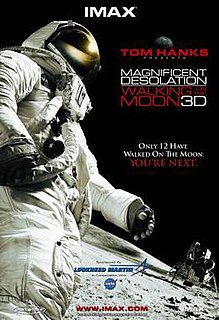 W
WMagnificent Desolation: Walking on the Moon 3D is a 2005 IMAX 3D documentary film about the first humans on the Moon, the twelve astronauts in the Apollo program.
 W
WMars is a documentary and hard science fiction television series produced by National Geographic, which premiered on November 14, 2016, on their channel, and FX. Prior to its official air date, it was launched in a streaming format on November 1, 2016. It blends elements of real interviews with a fictional story of a group of astronauts as they land on the planet Mars.
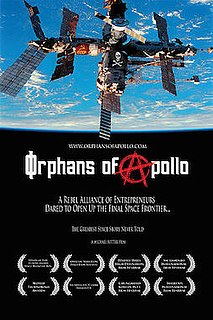 W
WOrphans of Apollo is a 2008 documentary film directed and produced by Michael Potter, co-directed by Becky Neiman and edited by Todd Jones, which describes how a band of entrepreneurs tried to privatize the space station Mir and tells the story that led to the development of MirCorp. It features prominent NewSpace entrepreneurs and space advocates, backed financially by Walter Anderson.
 W
WOur Heavenly Bodies is a 1925 German educational film written by Hanns Walter Kornblum and Ernst Krieger which attempts to represent everything known about the cosmos at the time. It covers the origin and mechanics of the Solar System, gravitation, the stars, and the nature of galaxies.
 W
WPassage de Vénus is a series of photographs of the transit of the planet Venus across the Sun in 1874. They were purportedly taken in Japan by the French astronomer Pierre Janssen and Brazilian engineer Francisco Antônio de Almeida using Janssen's 'photographic revolver'.
 W
WThe Planets is an educational miniseries produced by the BBC and A&E and released in 1999. The series was remastered in 2004. It documents the Solar System and its nature, formation, and discovery by humans during the space age. The series of eight episodes includes a substantial amount of archival footage from both the United States and Soviet space programs. It also depicts the Solar System through computer graphics. There were a total of eight episodes produced for the series. The series featured appearances from famous pioneering space scientists and explorers, and was narrated by Samuel West in the original 1999 edition, and Mark Halliley in the 2004 remastered edition.
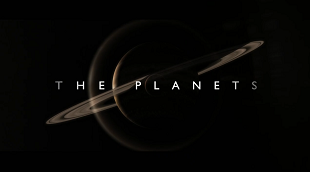 W
WThe Planets is a 2019 BBC/PBS television documentary series about the Solar System presented by Professor Brian Cox in the UK version and Zachary Quinto in the US version.
 W
WRoving Mars is a 2006 IMAX documentary film about the development, launch, and operation of the Mars Exploration Rovers, Spirit and Opportunity. The film uses few actual photographs from Mars, opting to use computer generated animation based on the photographs and data from the rovers and other Mars probes. The film has been released on Blu-ray disc by distributor Disney.
 W
WA Sidewalk Astronomer is a 2005 documentary film about former Vedanta monk and amateur astronomer John Dobson. The film follows Dobson to state parks, astronomy clubs, and downtown streets as he promotes awareness of astronomy through his own personal style of sidewalk astronomy. The documentary includes voice overs by Dobson himself promoting his unorthodox views on religion and cosmology.
 W
WSpace is a 2001 BBC documentary which ran for six episodes covering a number of topics in relation to outer space. The series is hosted and narrated by actor Sam Neill.
 W
WSpace Station 3D is a 2002 Canadian-American 3D short documentary film about the International Space Station written, produced, edited and directed by Toni Myers. Narrated by Tom Cruise, it is the first IMAX 3D production filmed in space.
 W
WStephen Hawking's Favorite Places is an original documentary series that was released exclusively on CuriosityStream, in partnership with production company Bigger Bang. Stephen Hawking stars in and narrates the series, in which he pilots a Computer-generated imagery (CGI) space ship across the Universe, making stops at some of his favorite places and discussing the scientific significance of each location.
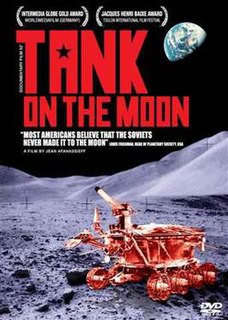 W
WTank on the Moon is a French 2007 documentary film about the development, launch, and operation of the Soviet Moon exploration rovers, Lunokhod 1 and Lunokhod 2 in the period from 1970 to 1973. The film uses historical footage from American, Russian and French archives featuring Leonid Brezhnev, Yuri Gagarin, Lyndon Johnson, John F. Kennedy, Nikita Khrushchev, Sergei Korolev, Alexei Kosygin, Alexei Leonov, Sam Rayburn and many other contemporary figures. A special emphasis is placed on the Lunokhods' chief designer, Alexander Kemurdzhian.
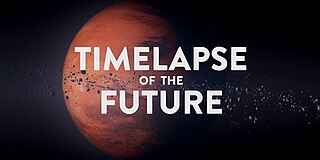 W
WTimelapse of the Future: A Journey to the End of Time is a 2019 short animated pseudo-documentary web film created by American astronomy-themed musician and filmmaker John D. Boswell, following Timelapse of the Entire Universe. The 29-minute film is a flowmotion— combination of a hyperlapse, time-lapse, and regular shots— of the universe from 2019 to the end of time, comprised with self-made and fair use footages from films, the Internet, and speeches from scientists, with the lapse doubling every five seconds, using current knowledge, combining different hypotheses.
 W
WYear Million is a six-part documentary and science fiction television series produced by National Geographic, which premiered on May 15, 2017, on their channel. The series received two Emmy Award nominations, including a Primetime Emmy for its narrator Laurence Fishburne. The series is based on the 2008 book Year Million: Science at the Far Edge of Knowledge by Damien Broderick. The narrative alternates between the years 2050, 3000, 500,000 and Year Million, using 2016 interviews to explain events unfolding in the story. The series was filmed in Budapest.